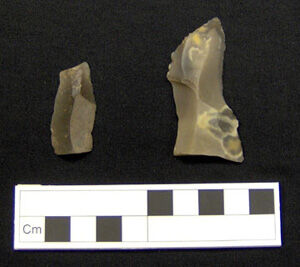University News Last updated 29 January 2009

An excavation project at Birmingham City University's proposed Eastside campus grounds has unearthed evidence of human activity from more than 9000 years ago. The dig uncovered two stone flint blades possibly used for cutting, and likely to have been dropped by prehistoric man.
The excavations and environmental survey also revealed evidence for woodland clearance in what would have been a boggy area of land during prehistoric times.
The dig was undertaken by the University of Leicester Archaeological Services between October and November 2008, and was supervised by archaeologists from consultants, Arup. It concentrated on the area between Park Street Gardens, Bartholomew Street and New Canal Street. In the 16th century, this area was outside the built-up area of medieval Birmingham known as Little Park.
Archaeologists believe the flint blades may have been used for cutting, and are likely to have been dropped by prehistoric people, who were perhaps hunting for food in this area.
Graham Rhodes, Director of Estates at Birmingham City University, said: "Finding these prehistoric relics are amazing. We knew the excavation would unearth some interesting things, but I never thought it would hark back to prehistoric times.
"To think that these items have been lying in the ground for more than 9000 years ago is astonishing. This really is a case of old meets the new, as the area that was under excavation will become the University's new city centre campus for cultural and creative activities.
"It's a fantastic find, the archaeologists have said evidence of this period within Birmingham is extremely rare, and the excavation could help to show what this part of the city looked like in prehistoric times. It's good to know that the University has played its part in revealing some of Birmingham's history."
Archaeologists from the University of Leicester have taken samples of sieved clay from the site to find small organic remains. Environmental specialists in charcoal, plant, pollen and beetle remains are studying the results to find out about the landscape that these early humans would have encountered.
Vicki Score, Project Manager of the University of Leicester Archaeological Services, said: "It's amazing that despite all the buildings on the site that so much of this clay layer has survived. The beetles, pollen and charcoal in it are currently being carefully studied by experts who will hopefully be able to tell us what the landscape looked like all those years ago."
Samples from the clay have also been sent off for radiocarbon dating to verify the initial findings.